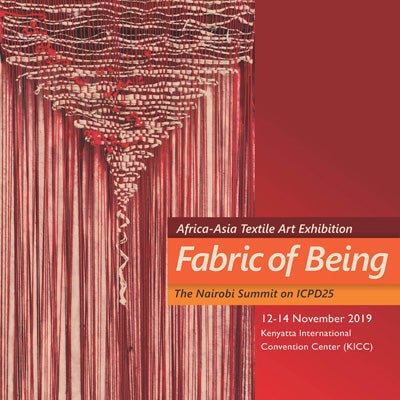The Fabric of Being: Textiles, Gender Equality and the Empowerment of Women, Nairobi Summit
Textiles are inextricably linked to our lives, essential to our survival and powerful signifiers of our existence.
In the Fabric of Being textile exhibition at the ICPD25 Nairobi Summit, renowned artists and designers from Africa and Asia reflect upon womanhood, women’s rights, gender equity, fertility, contraception, diversity, violence against women and other issues that both emanate from and are woven into the ICPD Programme of Action.
While the creators come from different countries and use diverse types of textiles in their work, they explore universal and fundamental themes at the heart of the agenda in Nairobi.
There is a precedent for this metaphor.
In 2012, UNFPA titled one of its publications Women Are the Fabric to stress that women hold societies together, including in times of crisis, as they weave the tapestry of life to ensure and strengthen the health, security and well-being – the very cohesiveness – of families and entire communities.
This metaphor expands into new interpretations and representations at the Fabric of Being display. The collection of artworks resonates with the central themes of the Nairobi Summit: gender and power, sexuality and reproduction.
The works also resonate with current broader contextual issues that affect the agendas of equality and sustainable development, as addressed by the Nairobi Summit’s signature sessions, such as social inclusion, urbanisation and climate change, reflecting key issues that underpin the Programme of Action as well as the wider canvas within which ICPD sits.
The presented artworks, installations and performances feature different kinds of textiles—from handmade batik and crochet to khanga, sarong and used cloths. From their culturally diverse perspectives, they invite visitors to discover multiple layers of meaning expressed in the forms, colours and technologies applied and the kinds of fabrics used.
The symbolic richness of the exhibit reveals both the ceremonial and everyday use of textiles in defining people— and women in particular— as they move through the entire life cycle, negotiating sexuality, fertility, reproduction, relationships, childbirth, health, illness and – inevitably – death.
Gender norms and roles, including those that shape the division of labour in the production of textiles, from spinning and weaving to tailoring, are challenged.
A fabric’s social function also emerges as the individual artworks, and the exhibition as a whole, give voice to the unspoken, encourage the audience to embrace alternative visions, and make bold and explicit statements on diversity, equity and rights.
The collaboration and conversation among African and Asian artists and organizations ultimately embodies the Nairobi Summit’s spirt of innovative partnerships in harnessing creativity for social causes. The exhibition is thus not only an aesthetic addition to ICPD25, but contributes to the Summit’s aspirations of fully realizing an inclusive Programme of Action underpinned by sexual and reproductive health and rights for all.
The conceptualizers and coordinators
The Fabric of Being exhibition was inspired by Natalia Kanem, Executive Director of UNFPA, and is conceptualized and organized by SEA (Southeast Asia) Junction in Bangkok headed by Rosalia Sciortino Sumaryono, in collaboration with TICAH (Trust for Indigenous Culture and Health) and its founder Mary Ann Burris in Nairobi, with curatorial and creative contributions from the Nest Collective and the Performance Collective, and financial and logistical support by UNFPA.
All the organizations and the artists involved have worked closely together sharing a belief in the transformative power of art and textiles.
The artists and their stories:
Excerpts from the full Fabric of Being catalogue (download here)
The Flaming Womb: Pankaja Sethi, India (silk and cotton)
Pankaja’s textile artwork The Flaming Womb examines the gap between the symbolic and power attributes of womanhood and the role and conditions of women as dictated by a patriarchal society.
The artistic depiction of the uterus and womb as sources of power represents women who are negotiating for a space against forces that want to confine their power and make them invisible and unheard.
The womb is flaming and burning from women’s anger and resistance in the face of all the injustices they experience.
Women’s Circle of Life: Yemisi Ajayi, Nigeria (cotton)
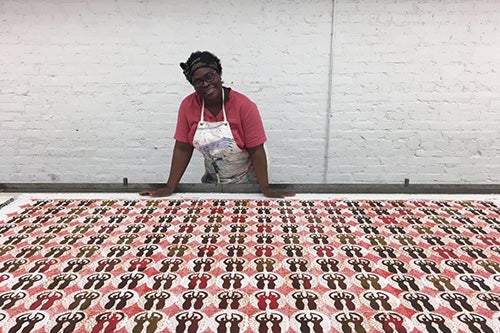
Yemisi Ajayi creates mixed-medium textiles. Courtesy of the artist.
This majestic fabric entitled Women’s Circle of Life is an eloquent example of Yemisi’s work, in which she expresses her artistic and spiritual emotions, her experience as a woman and her awe for the wonder of the natural world.
This mixed-medium textile art piece symbolizes Yemisi’s reflection on women’s reproductive health and the role women play in replenishing the Earth’s mystery. It tells about the strong women of all ages all over the world and embodies female reproductive health and women’s empowerment, rather than weakness and inferiority as often portrayed by patriarchal cultures.
Gender Metamorphosis: Aze Ong, The Philippines (chenille, cotton, acrylic, bamboo, silk, furry and wool)
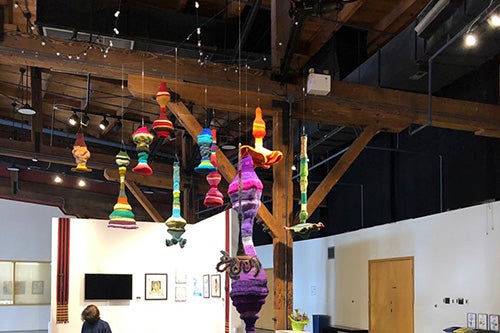
Aze Ong’s works celebrate diversity. Courtesy of the artist.
Aze Ong’s works celebrate diversity. Courtesy of the artist.
The installation of 58 colorful crochet pieces hung from the ceiling speaks of gender roles and their transformation in multiple ways. They embody the complex histories of women weavers from diverse ethnolinguistic communities all over the Philippine archipelago.
These exhibits also refer to women’s double roles in the domestic and public sphere and the tensions that they create. The installation elevates the feminized practice of crocheting to cosmopolitan art. At the same time, this installation rejects the binaries of gender and celebrates the rainbow of colors. It breaks away from reductionist views on reproduction and sexuality still persisting in the Philippines and many other countries by hinting at penises and vaginas, the fluidity of sexual orientations and joyful pleasure.
If for feminism the personal is political, for Aze it is also art—an art that stitches and intertwines the narratives of women in everyday scenarios and across places, nationalities, and geopolitical boundaries.
Sisterhood: Dilomprizulike (also known as ‘The Junkman from Africa’), Nigeria (used clothes and wood and other used and discarded objects)
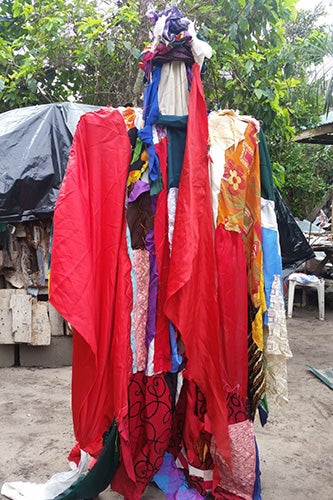
Dilomprizulike’s work confronts and interweaves cultural attitudes and traditional practices. Courtesy of the artist.
Dilomprizulike’s work concentrates on the city and city life as a curious concept of modernity, which in Africa, but also in other locations, both confronts and interweaves with cultural attitudes and traditional practices.
He explores the aspirations of people living in urban settings and the gaps between those who can access and use available resources and the disenfranchised who live at the margins of mainstream society. The artwork conceived for the Nairobi exhibition translates these approaches into a charming and unique representation of sisterhood.
The beauty, diversity, strength, and resilience of women emerge from the discarded material used to compose a group of five women standing together for a more just and sustainable world.
Textile Truths: Mali Ya Abdulla, Kenya (cotton)
The khanga is ubiquitous in Kenya and Tanzania. It is also found in many parts of central and southern Africa, and as far away as the Middle East. Khangas can express powerful messages without uttering a single word.
At the Nairobi exhibition, a selection of khangas is constructed around two main ideas. The first is the khanga as an arbiter of women’s autonomy, especially in their expressing erotic feelings and sexual desires, which are key to conversations about reproductive health, and beyond health, wellness. As affirmed in the ICPD Programme of Action, loving and being loved in the way that one wants is key to comprehensive sexual and reproductive health.
The second idea explored is that of the woman as a social pundit, purveyor of folk and holistic wisdoms, and political analyst. In some khangas here, she is hopeful, in others resigned, in others indignant. The traditional maxim that women should be seen and not heard is ironic when juxtaposed with the khanga, which is, indeed, seen and not heard: however, the woman wearing it is far from silent.
Kaderdina Hajee Essak Limited, popularly known as Mali Ya Abdulla, is a company and store based in Mombasa, focusing on textiles and especially the khanga.
Khanga Conversations: The Performance Collective, Kenya
The Nairobi exhibition includes an interactive community story-telling performance that combines the history of the khanga as a cosmopolitan African fabric with connections to different parts of the world with stories celebrating its rich history since its creation on the Swahili Coast.
Khanga Conversations particularly highlights the primary association of the khanga with girls and women and its amplification as a gendered “fabric of being” that carries history, culture, life lessons and articulations of experiences, aspirations and perceptions. The performance is about the “cloth that speaks” through its mix of verbal and visual art and its multi-faceted messaging. Its story-telling celebrates the khanga for the voice it has given to women in promoting their well-being, health, and dignity, especially with regard to their life choices, relationships, reproductive rights, and socio-political power.
The Performance Collective is the performance arm of The Orature Collective (TOC), a group of Nairobi-based creative intellectuals who create and facilitate safe spaces for communal explorations of issues of collective interest.
Fertility: Nia Fliam and Agus Ismoyo, Indonesia (cotton and silk)
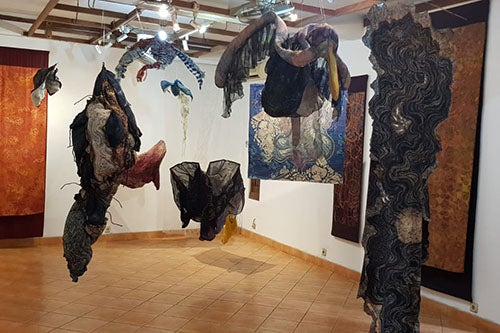
This installation reflects the cycles of life. Courtesy of the artists.
The ancient Javanese text “Agastyaparwa” associates the ant with fertility and describes it as a powerful symbol of how the cycles of human reproduction are intertwined with the environment. The textile art installation “Fertility” illustrates the cycles of life’s reproduction on Earth with 26 artworks made in the medium of batik and tie-dye.
At the core of the installation, there are pieces representing the ant house, the life of ants, and the elements of water, earth, and air. The installation also includes four pieces of sarong (sarung in Indonesian), depicting the seen and unseen aspect of our existence as well as the four directions of the earth. One more sarong with soft sculptures inside shows the stages of a woman’s life first as a young girl, then a woman and finally an aged person (or grandmother). In addition, there are two videos: one of a woman walking, representing the dynamic nature of life’s transformations and one of the life of ants in their constant activity of working together.
Agus Ismoyo (Indonesian) and Nia Fliam (American) have been working collaboratively to produce art textiles in Yogyakarta, Indonesia, since 1985. Ismoyo’s ancestors were batik makers, and he was trained in industrial management at the Industrial Academy (AKPRIND) in Yogyakarta. Nia originally explored dye resist techniques from Africa and Asia in America, before moving to Indonesia in 1983 to study traditional batik.
Goddess of Water: Aboubakar Fofana, Mali (hand-sewn linen)
Aboubakar’s work stems from a profound spiritual belief that nature is divine and that through respecting this divinity we can understand the immense and sacred universe.
He uses indigo, a dye different than any other obtained through a living fermentation process that does not require any mordant. The indigo used for the hand-made textile is closely related to fertility in different ways. Indigo has been used for centuries in Africa as a symbol of wealth and fertility and also had medicinal use.
More directly, for women who are having difficulties conceiving, the advice is to wear a skirt dyed with the fermented leaves as traditionally it is thought that indigo cures infertility. Also, traditionally, indigo-dyed textiles bring well-being to pregnant women and ensure a healthy growth for the child. Babies are laid down in indigo-dyed sheet to stimulate their minds. The blue stripes of the exposed four meters-long cloth with all their different tonalities refer to water and other liquids essential to life, starting from the amniotic fluid protecting the growing fetus and providing it with the necessary nutrients and chemicals.
Blue is what is visible of indigo, but the unseen is the spirit of the plant that transforms, the leaves fermented with live bacteria that from green become blue when exposed to air in a process as mysterious and astounding as birth itself.
Signs of the Now: José Hendo, Uganda (hand-woven bark cloth and organic cotton)
This artwork is in direct response to what is happening in our planet at the present time. Landfill space running out, the plastic in the oceans, forests burning and glaciers and polar ice melting. If we do not act now to stop environmental degradation and climate change, when? The responsibility lies with everyone. Taking inspiration from her past concepts, research, and designs, José’s installation and collection Signs of the Now urges all of us to stop being wasteful immediately.
The dominant material of her artwork is bark cloth, which is biodegradable, organic and manufactured without the use of chemicals. This organic cloth, predating the weaving era and proclaimed a UNESCO World Heritage Material in 2005, is the best ambassador for sustainability: it truly is The Fabric of Being!
The depiction of the planet, hand carved out of bark cloth, stands for the how we are all connected and have to act together. At the centre of the planet is Africa, referring to the origin of the artist, but also to the disproportionate effect of climate change on populations in Africa and Asia. The laser-cut bark cloth beyond the planet further signifies how fragile the environment has become through our actions. And it is through our actions therefore that we have to remedy the destruction of our habitat.
Born from the Same Womb: Abdi Karya, Indonesia (textile art installation and performance)
This textile art installation is composed of ayunan (swings or cradles) and dolls made from sarongs from the artist’s birthplace, the province of South Sulawesi in eastern Indonesia.
Abdi’s artwork calls for pluralism and inclusiveness in the face of growing sectarianism, intolerance, and identity politics in Indonesia and beyond. He explains how sarongs mark and accompany the entire life cycle: birth, childhood, adolescence, adulthood, social and sexual interactions and marriage, in health and sickness, and until our death.
The installation challenges the growth of fundamentalist and sectarian movements in Indonesia and globally, and calls each one of us to action since attacks on “the other” are attacks to our shared humanity.
Sis, You Betta Werk: Siwa Mgoboza, South Africa (Shweshwe [three cats cotton], tulle, glass beads and cotton)
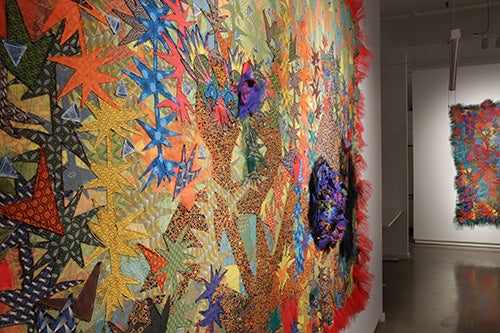
“Sis, You Betta Werk” represents a wide range of people who exist on the fringes of society. Courtesy of the artist.
“Sis, You Betta Werk” represents a wide range of people who exist on the fringes of society. Courtesy of the artist.
This colorful artwork is inspired by “Olympia,” a painting by Edouard Manet that was controversial at the time, as it portrayed a brothel setting and a naked courtesan facing the viewer with a servant sitting in the back. Siwa’s tapestry reproduces the same scene in the artist’s specific style to interrogate the importance and value society has placed on the lives of people who work in the sex industry: women, men and the non-binary – many of whom are murdered and raped every day.
For Siwa, the artwork displayed at the Fabric of Being exhibition represents a wide range of people who exist on the fringes, people who usually come from disadvantaged backgrounds, are placed in a subordinate position like women, are considered outcasts like sex workers and persons outside of the heterosexual paradigm, or a combination of these.
Women’s Resilience: Keeta Isran and Salwanee Hajisamea
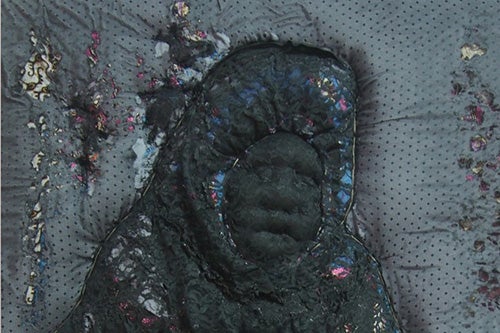
Resilience is a major theme in Keeta Isran and Salwanee Hajisamea’s work. © Prach Pimarnman
Women’s resilience is the focus of a set of tapestries composed of artworks created by Keeta Isran and Salwanee Hajisamea. Both artists are based in Thailand’s troubled deep south, a historically and culturally distinct area consisting of the provinces of Pattani, Yala, Narathiwat, and parts of Songkla along the borders with Malaysia. The Malay Muslim population is the border area’s majority, but constitutes a minority in the majority Thai and Buddhist country.
In the midst of recurrent tensions, Keeta and Salwanee are united in the goal to show the resilience of local women, who go ahead with their daily life and continue to work and support their families irrespective of the difficulties they encounter.
Together the five art pieces highlight that even in a troubled area, beauty can be found in the courage and strength of women.
Source: https://www.nairobisummiticpd.org/news/fabric-being-textiles-gender-equality-and-empowerment-women

